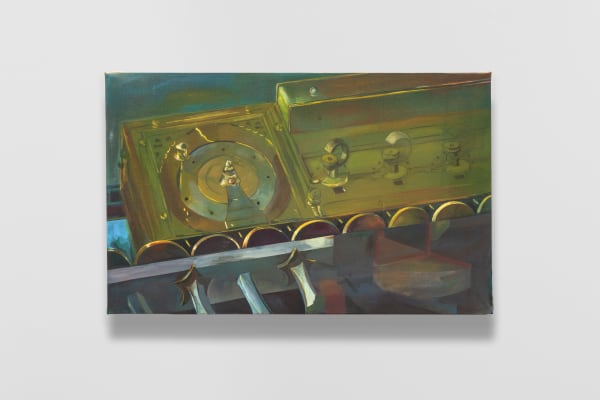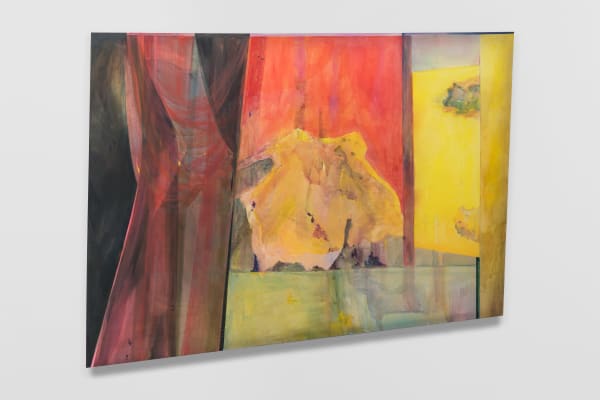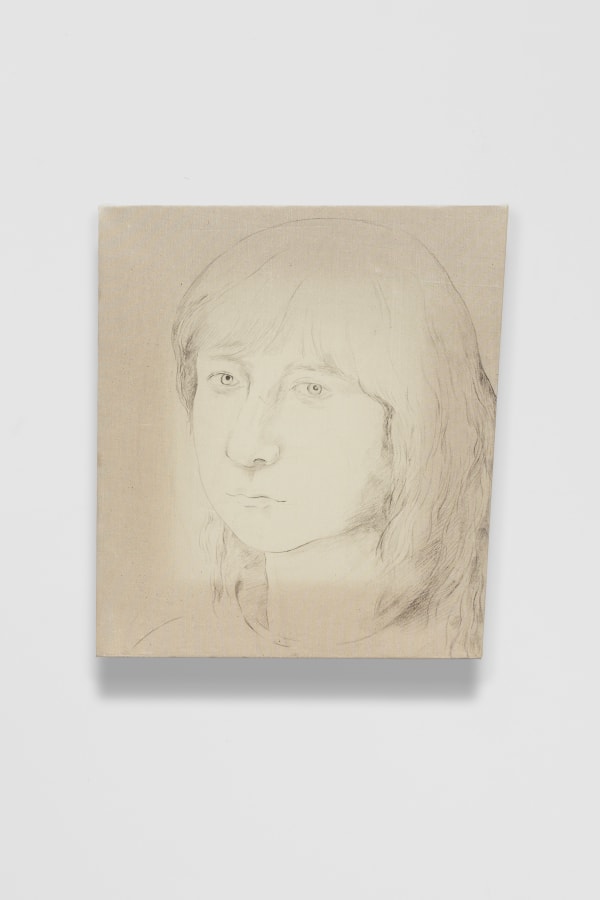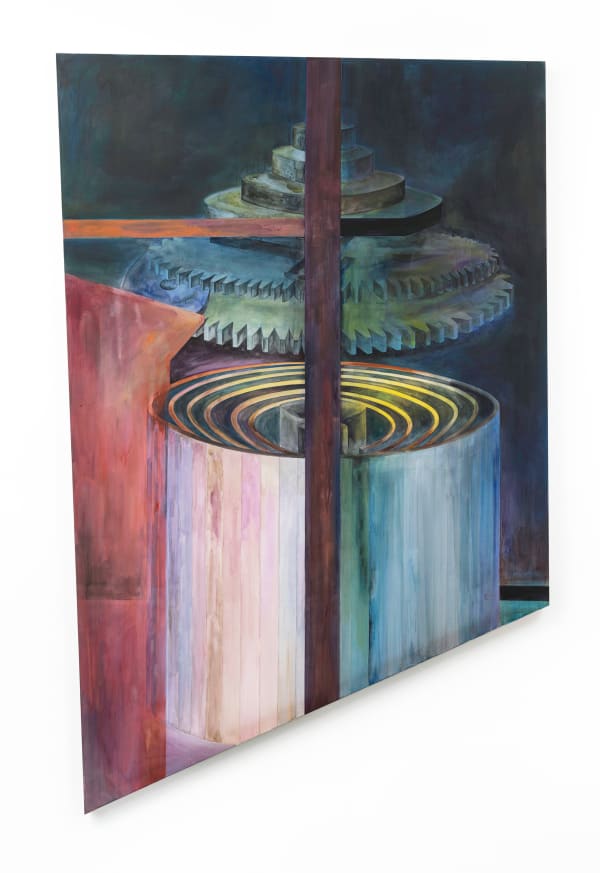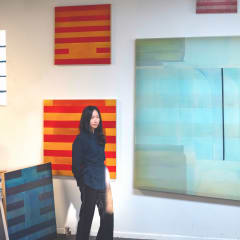Leah Ke Yi Zheng
Mendes Wood DM, Brussels is pleased to present Leah Ke Yi Zheng, the artist’s first European solo exhibition. Leah Ke Yi Zheng (b.1988) grew up in Wuyishan (China), where she was apprenticed in traditional Chinese painting techniques from an early age. With a dialectical relationship to tradition, she developed a practice in painting that incorporates ancient Chinese approaches akin to Wang Xizhi’s “spiritual calligraphy” and “picture of the mind” techniques alongside her own formalist response to Western artists including Hilma af Klint, Fra Angelico, and Blinky Palermo. While often in intellectual and aesthetic conversation with these traditions and figures, her works are, for the artist, equally “engaged through their solitude, as we are as individuals.”
Zheng’s paintings call for attentive viewing that takes into account how the works are made. Beginning with a somewhat anarchic approach, her self-made wooden stretcher frames are guided by intuition, taking on distinct shapes – slightly uncanny parallelograms that deviate from the rectangular norm. The frames then determine the images on the canvas, which balances the irregularity of their shapes. Materials like silk and wood selections such as mahogany, purple heart, and cherry serve not only as mediums but as metaphors for layers of memory and observation – silks as light, translucent, and evanescent as the wood is heavy and warm. Through her choice of the viewing distance and subject matter and by varying the transparency of paint embedded in silk canvas, Zheng takes control of the layers of legibility in her images. Influenced by Korean-German philosopher Byung-Chul Han, Zheng’s transparency recurs as a technical and conceptual motif, and it is through games of legibility, illegibility, and memory that she plays with the viewer’s perceptions of image and objecthood.
In Zheng’s process of approaching German philosopher and mathematician Gottfried Wilhelm Leibniz’s “Monadology,” each work reflects a moment unto itself while hinting at a universal interconnectedness. This sheds light on the artist’s understanding of her works in conversation with each other. In Untitled (Window), 2023 the focus is on folding ephemeral organic forms while in Untitled (Leibniz’s Calculus machine), 2024 the stark precision of mechanical apparatuses takes the fore. At other times, it is through networks of references – for example, within a series of small portraits Untitled (Pasolini’s Riccetto), 2024, Untitled (Nijinsky), 2023, and Untitled (Sick Man of Roger de La Fresnaye), 2023 – that Zheng observes through duplications, deletions, and inversions unveiling connections, relations, and resemblances.
Zheng reflects on her practice as inflected by motifs and variation, “Motif is the academic term, but I prefer to call them forms: Curtains and folds, the fusée (an engine of time), the machine in general, and my off-vertical black stripe.” Throughout the development of her works, such forms undergo many changes – transformed, substituted, altered, and deviated. When forms and variation collide, a gradual process of revealing occurs: Unfolding through a leveling of authorship and coexistence of silence, stillness, and living energy.
Leah Ke Yi Zheng (b. 1988 Wuyishan, China) lives and works in Chicago.
Zheng received her MFA from School of the Art Institute of Chicago (2019) where she teaches since 2021. She was awarded the 2019-2021 fellowship from The Arts Club of Chicago.
Recent solo and two person exhibitions include Castle Gallery, Los Angeles (2024); David Lewis Gallery, New York (2023); 4th Ward Project Space, Chicago (2023); Arts Club of Chicago, Chicago (2022). Recent group exhibitions include Zeno X Gallery, Antwerp (2023); Caffé Centrale, Monte Castello di Vibio (2022).
Leah Ke Yi Zheng asked me to write something for her exhibition, maybe because we’ve known each other for some time and we have an uncommon rapport, but knowing her work and describing it seems like a fool’s errand and she knows it. That said, I’ve always been impressed with the thoughtfulness, restraint, and seemingly paradoxical indulgence of Leah’s work. As an artist, she’s adopted much from eastern and western traditions, primarily through an understanding of how to create a situation that can lead to an epiphany; whether that’s from the architecture of Zen gardens or the situation of land art - the kind of artworks that are meant to be walked as well as viewed and experienced over an extended period of time and that seem to constantly change. It’s easy to be drawn into Leah’s work by its visual abundance and the way it connects to complex ways of seeing and how we consider our place in the world. But to enter this thicket, it’s necessary to begin somewhere, with an element, a piece of the whole that then begins an irregular and circuitous path forward where a viewer must first focus on the immediate situation of her work before arriving at a place where perceptions open up and the possibilities of the nature of the experience come forward. Leah’s work is not logical, it plays with and subverts our expectations. Her work asks a viewer to follow her into the moment where we let go of the desire to make sense, and in the process reveals a deeper understanding of being present. This may be most evident in the division inherent in this exhibition between the two sides of the gallery, one bathed in light and color and the other darker with an emphasis on value and definition. Both expressions retain their own character and integrity but as we walk the exhibition the differences close through the flow of her work and we feel it as much as we see it.
— Gaylen Gerber
-
 Leah Ke Yi Zheng, No. 58, 2024
Leah Ke Yi Zheng, No. 58, 2024 -
 Leah Ke Yi Zheng, Untitled (Nijinsky), 2023
Leah Ke Yi Zheng, Untitled (Nijinsky), 2023 -
 Leah Ke Yi Zheng, No. 61, 2023
Leah Ke Yi Zheng, No. 61, 2023 -
 Leah Ke Yi Zheng, No. 60, 2023
Leah Ke Yi Zheng, No. 60, 2023 -
 Leah Ke Yi Zheng, No. 40, 2023
Leah Ke Yi Zheng, No. 40, 2023 -
 Leah Ke Yi Zheng, Untitled, 2023
Leah Ke Yi Zheng, Untitled, 2023 -
 Leah Ke Yi Zheng, Untitled (Leibniz's Calculus machine), 2024
Leah Ke Yi Zheng, Untitled (Leibniz's Calculus machine), 2024 -
 Leah Ke Yi Zheng, Untitled, 2024
Leah Ke Yi Zheng, Untitled, 2024 -
 Leah Ke Yi Zheng, Untitled (Pasolini’s Riccetto), 2024
Leah Ke Yi Zheng, Untitled (Pasolini’s Riccetto), 2024 -
 Leah Ke Yi Zheng, Untitled (Man in bed of Roger de La Fresnaye), 2023
Leah Ke Yi Zheng, Untitled (Man in bed of Roger de La Fresnaye), 2023 -
 Leah Ke Yi Zheng, Untitled (Fusée), 2023
Leah Ke Yi Zheng, Untitled (Fusée), 2023 -
 Leah Ke Yi Zheng, Untitled (Nijinsky), 2023
Leah Ke Yi Zheng, Untitled (Nijinsky), 2023 -
 Leah Ke Yi Zheng, Untitled (window), 2024
Leah Ke Yi Zheng, Untitled (window), 2024







